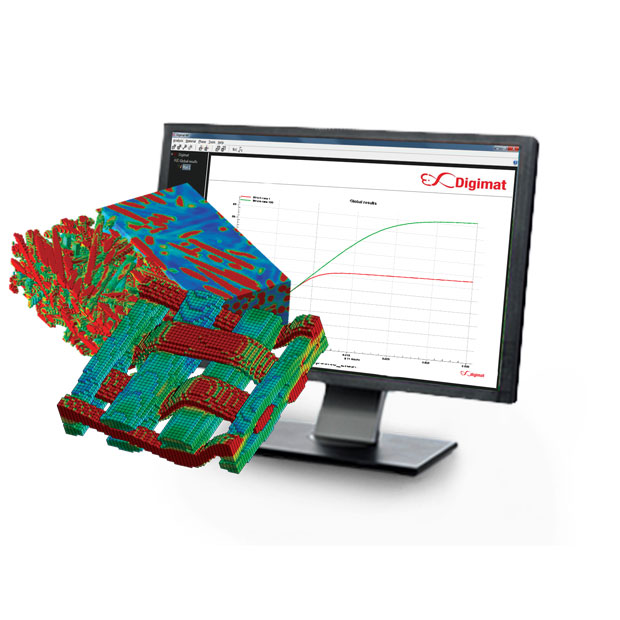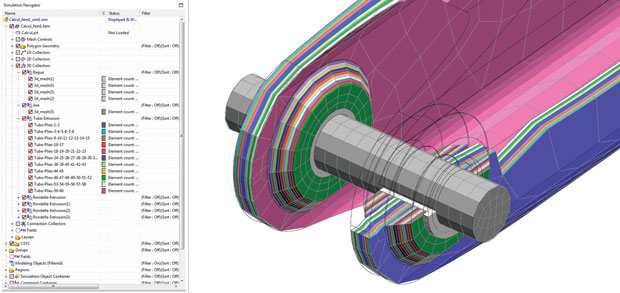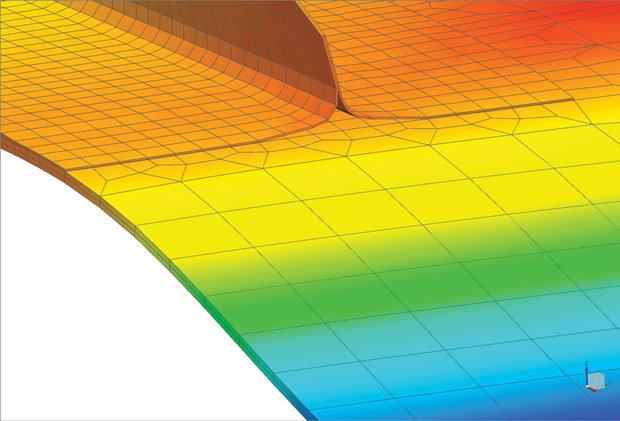
Digimat from e-Xtream engineering comes with a database that includes both typical properties for common composite materials and the more accurate, grade-specific values, made available to Digimat by the composite suppliers. Image courtesy of MSC Software.
Latest News
October 1, 2015
 This image shows a partial cutout of a composite tube, composite washers, steel bolt and rings. Image courtesy of Siemens PLM Software.
This image shows a partial cutout of a composite tube, composite washers, steel bolt and rings. Image courtesy of Siemens PLM Software.In the heart of Derbyshire, church steeples, wooded valleys and manor houses preserve the tranquil British countryside depicted in the classics of Jane Austen and Sir Walter Scott. It’s an unlikely setting for composite material testing, one of the most advanced areas of exploration in modern manufacturing. Yet, in Darley Dale, Derbyshire, you’ll find HBM nCode’s Advanced Materials Characterization and Test (AMCT) Facility, located a mere 15-minute walk from St. Helen’s Church.
Composite materials are different from traditional materials like metal or plastic. They’re engineered to achieve the desired durability, elasticity and resistance. Because they’re produced by mixing different material strands, fibers and plies, they’re anisotropic and inhomogeneous. In layman’s terms, they do not deform, stretch and break in the same way in all directions.
Simulation software relies on material models—numeric equations that express the way the materials react to heat, load, stress and pressure—to make accurate predictions of manufactured parts’ mechanical behavior. “With anisotropic composites, simulation-driven design is especially important, because your simulation results completely define the structure and shape of your design. You also need to simulate how you manufacture the material, because how you lay the fibers affects your material’s performance,” says Ganesh Sethuraman, senior marketing manager at Siemens PLM Software.
Knowledge about composite materials is not readily available in engineering reference books or standard material databases; therefore, testing facilities like nCode’s AMCT in Darley Dale play a crucial role. Without their services to ascertain the composites’ responses to loads, stresses and pressures, engineers cannot conduct simulation to fully exploit the benefits of the new materials to produce designs of things like lightweight automotive frames and airplane wings.
Finding the Material’s Breaking Point
Material testing is usually done by exerting pressure and loads on a sample specimen called a “coupon.” The AMCT facility uses “hydraulically loaded strain-control test machines,” says Jon Aldred, director of Product Management at HBM nCode. The facility is ISO 9001-certified.
“We do fatigue testing for customers who request them. We also do testing to build up our own Premium Material Database, which is included in our software,” says Aldred. “When it comes to composites, our primary focus is to understand the effects of stress and strain cycles and how many cycles it takes for the material to break or fail. This is still a very challenging area of composites technology. We spend a lot of time validating and improving on mathematical fatigue models for composites.”
 Digimat from e-Xtream engineering comes with a database that includes both typical properties for common composite materials and the more accurate, grade-specific values, made available to Digimat by the composite suppliers. Image courtesy of MSC Software.
Digimat from e-Xtream engineering comes with a database that includes both typical properties for common composite materials and the more accurate, grade-specific values, made available to Digimat by the composite suppliers. Image courtesy of MSC Software.With composites, the layout of the fiber strands and plies affect the material’s strength and resistance; therefore, unlike steel or metal, composites react differently to stress, load and pressure in different directions. “So we have to test and record their reactions from several angles to accurately characterize them,” Aldred says.
nCode’s database includes fatigue parameters for more than 90 materials. It’s accessible through the nCode Complete Durability System consisting of GlyphWorks and DesignLife for fatigue and durability analysis. CAE software vendors have shown an interest in integrating nCode’s database into their software, Aldred says. But currently nCode’s Premium Material Database is not part of any other CAE packages.
Material testing facilities characterize the behavior of materials, but do not typically provide design testing services. nCode’s AMCT, for example, does not usually perform fatigue-testing services for large structural components or assemblies made of composites. “But we have been involved in such cases in a consultancy role. We can test smaller components but they’re considered special projects,” says Aldred. A shortage of on-demand service providers in this area suggests many manufacturers must conduct such tests in-house at considerable expense. This is especially true if the part to be tested is large enough to require special rigs and machines.
The Elusive Composite Database
Asking for a database of composite materials is like asking for a chart that lists all the colors producible from a set of primary colors. You can easily list all the primary colors in a table, just as you could with types of metal. In both cases, the number is finite. But the variety of shades you can achieve from color mixing is virtually infinite. Similarly, the variety of composites you can create from weaving and stacking different material fibers in different configurations is virtually infinite.“There’s no one material database for composites,” says Siemens’ Sethuraman. “In my experience, customers do their own testing to get the data on their composites. That’s the knowhow and competitive advantage for some customers.”
However, a list of premade composite materials readily available for purchase is not out of the question. Material suppliers usually have the simulation-relevant data (such as resistance, tensile strength and thermal properties), obtained from their own lab tests. Some suppliers are willing to part with it; others treat it as trade secret. However, if a manufacturer has engineered a composite material in-house for a specific purpose, lab testing is the only way to obtain these critical values.
One composite database can be found in the Digimat software suite from e-Xstream engineering, which describes itself as “the material modeling company.” In 2012, simulation software developer MSC Software acquired the company.
The Digimat-MX database includes both typical properties for common composite materials (and more accurate, grade-specific values, made available for modeling purposes with Digimat by the composite suppliers themselves). The software also has an interface that lets you add your own custom composite materials to the database. The database is server-based, so it can be centralized and made accessible company-wide.
“Material suppliers use Digimat to understand how the materials they’re producing behave, which direction offers better performance, and so on,” says Philippe Martiny, the software solution architect at e-Xstream engineering. “Original equipment manufacturers (OEMs) and Tier 1 suppliers from various industries (automotive, aerospace, consumer electronics, etc.) use Digimat to create high-fidelity 3D models to predict how their designs will behave to help them to attain lighter structure design, shorten development cycles and minimize the costly experimental tests.”
Digimat is fully interconnected with all of the major simulation tools on the market. It works with not just MSC products but also with other analysis programs, including those from MSC’s rivals. Martiny explained: “Some customers use MSC Nastran or any other FE (finite element) software for baseline stress analysis, then access Digimat through the software’s simulation environment for better insights into the effects on the materials: For example, what happens when you change the fiber orientation? How many plies do you need?”
Modeling the Material Making Process
“With composites, you spend a lot of times figuring out the layup [the arrangement of the plies]. That’s the work you typically don’t have to do with isotropic materials like structural steel,” says Siemens’ Sethuraman.
Siemens’ software portfolio includes Fibersim, a package for composites engineering. The company writes that the software “addresses the entire composites engineering process—from conception, laminate definition and ply creation through simulation, documentation and manufacturing. Fibersim is integrated into the leading commercial 3D CAD systems (CATIA, NX and Creo Parametric) to help you capture a complete digital composite product definition.”
In 2012, the same year MSC acquired e-Xstream engineering, Siemens snatched up LMS, a Belgium-based test and mechatronic simulation software developer. As part of the acquisition, Siemens added the LMS Samcef solver suite to its portfolio. The product can “accurately simulate the behavior of layered composite structures and their progressive degradation including delamination,” according to Siemens. It’s now integrated with Siemens’ NX CAE software. The company points out that the marriage of the two, combined with Fibersim, “creates an ideal integrated environment for the design, analysis and manufacturing of composite structures and components.”
Marrying Metal and Composites
The emergence of composites allows manufacturers to dramatically reduce the number of discrete parts in their assemblies. “Composites can be molded into the desired shape as a single part to replace what used to be three or four parts,” says Ana Wagner, global strategic marketing manager for Dow Automotive Systems.
Traditionally metal parts are assembled and held together with welds, bolts, rivets and fasteners. But the introduction of composites into the assemblies forces manufacturers to rethink. “Composites cannot be joined together using bolts and rivets. They’re much more brittle. You don’t want to pierce through them like you would with metal pieces,” says Wagner.
Dow Automotive Systems’ specialty is the use of adhesives to bond composites to composites and also composites to metal. “The special chemical in our adhesives creates a strong bond,” Wagner says. According to the company, its BETAFORCE and BETAMATE composite bonding adhesives “are based on a novel polymer technology that allows for consistent mechanical properties over an extremely wide temperature range, providing industry-leading temperature stability.”
 The image shows delamination modeled using the LMS Samcef nonlinear solver. For clarity only one half of the model is shown and the cohesive element that represents the bonding between the top two plies and the skin is hidden from view. Image courtesy of Siemens PLM Software.
The image shows delamination modeled using the LMS Samcef nonlinear solver. For clarity only one half of the model is shown and the cohesive element that represents the bonding between the top two plies and the skin is hidden from view. Image courtesy of Siemens PLM Software.The use of adhesives “reduces welded parts, which increases the vehicle’s load bearing capacity. It also reduces noise, vibration, and static and dynamic stiffness, leading to increased safety and crash behavior,” says Wagner. The challenge for advocates of digital prototyping is simulating what MSC’s Martiny described as “the load-transferring interface between composites and metal”—the joints. “When you’re looking at an assembly where composites and metal parts come together, you also need the extra ingredients to predict the behavior of the interface of the two,” he says.
In the case of Dow Automotive Systems customers, that “ingredient” may be the numeric characterization of the adhesive itself, which allows them to run digital simulation on assemblies with glued composite parts. “We [deliver the adhesive’s behavior] in a format consistent with our customers’ simulation tools. Each customer utilizes a specific software for simulations and we ensure the input provided matches their specific software,” says Mansour Mirdamadi, chief engineer at Dow Automotive Systems.
Breaking Out of the Metallic Mindset
Working with composites is a pioneering field, fraught with all the risks associated with experimental applications. While working with the unknown, some users are bound to over-design, observed Siemens’ Sethuraman. “They designed to meet a higher factor of safety because they didn’t have enough information about the composite materials they were using,” he says. That means they may have designed their parts with more material than necessary. While their precaution is understandable, the practice goes against the sole purpose of using composites—to produce smaller, lighter and thinner products.
“Even though companies are now working with stronger, lighter anisotropic composites, they still use traditional design methodologies for metal,” says Sethuraman. For example, metallic brackets are usually designed in an L-shape because that’s the time-tested form that works well in metal. But the same shape is not necessarily the best for composite brackets. To design with composites appropriately, engineers may need to also learn to break out of the metallic design molds.
More Info
Subscribe to our FREE magazine, FREE email newsletters or both!
Latest News
About the Author
Kenneth Wong is Digital Engineering’s resident blogger and senior editor. Email him at [email protected] or share your thoughts on this article at digitaleng.news/facebook.
Follow DE




